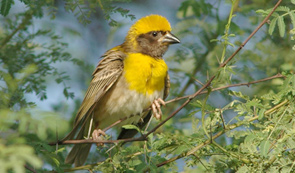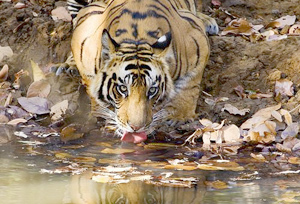Day 01: Arrive – Delhi
Day 02: Delhi – Jaipur (260 Km / 5 Hrs)
Morning after breakfast drive to Jaipur, on arrival check in at the hotel. In the afternoon city sightseeing tour of the Pink city visit, including City Palace, Hawa Mahal Palace of winds, natural observatory. Overnight at hotel.
Day 03: Jaipur – Ranthambore National Park (180 Kms / 3 ½ Hrs)
North & Central India Tiger Tour, Ranthambore Tiger Reserve, at the junction of the Aravalis and the Vindhyas, is a unique example of natural and historical richness, standing out conspicuously in the vast, arid and denuded tract of eastern Rajasthan, Tiger, at the apex of the food chain, lord over the kingdom in a subtle way. Solitary by nature, it operates in stealth. Therefore tiger sightings, frequent as they are, always a matter of chance. However, even evidences of tiger’s activities are very exciting. The other kinds of cats found in Ranthambore are Leopard (Panthera pardus), Caracal (Felis caracal), Leopard Cat (Felis bengalensis), Fishing Cat (Felis viverrina) and the Jungle Cat (Felis chaus). Besides the big cats, the other large predators found in Ranthambore include Sloth Bear, Striped Hyena, Wolf, Wild dog (or Dhole), Jackal, Indian Fox, Palm Civet, Small Indian Civet, Common Indian Mongoose, Small Indian Mongoose, Ratel (or Honey Badger), Marsh Crocodile and the Indian Python. There are two species of Antlers, namely the Spotted Deer (or Chital) and the sambar Deer, and, two kinds of Antelopes, namely the Indian Gazelle (or Chinkara) and the Blue Bull (or Nilgai).
Birds In Ranthambore – Ranthambore has over 330 species of birds and we are still counting. A keen birder can easily net over 120 species. For birders, Ranthambore’s specialties are the Indian courser, Painted spurfowl, Indian skimmer, quails, larks, pipits and prinias. One can have the beautiful birds from following spot like Surwal Lake, Mansarovar Lake, Misradhara gate, Amlidih on the Banas river.
Day 04: Ranthmbore National Park
Morning and afternoon safari to the national park. Overnight at hotel.
Day 05: Ranthmbore – Bharatpur (200 Km / 4 ½ Hrs)
Bharatpur Bird Sanctuary: North & Central India Tiger Tour One of the finest bird parks in the world, Bharatpur Bird Sanctuary (Keoladeo Ghana National Park) is a reserve that offers protection to faunal species as well. Nesting indigenous water- birds as well as migratory water birds and waterside birds, this sanctuary is also inhabited by Sambar, Chital, Nilgai and Boar.
Flora in Bharatpur: More than 300 species of birds are found in this small wildlife park of 29-sq-kms of which 11-sq-kms are marshes and the rest scrubland and grassland. Keoladeo, the name derives from an ancient Hindu temple, devoted to Lord Shiva, which stands at the centre of the park. ‘Ghana’ means dense, referring to the thick forest, which used to cover the area.
Major Wildlife Attractions: The major attractions of tourists visiting the park are the numerous migratory birds, who come from as far away as Siberia and Central Asia and spend their winters in Bharatpur, before returning to their breeding grounds. Migratory birds at Bharatpur bird sanctuary include, several species of Cranes, Pelicans, Geese, Ducks, Eagles, Hawks, Shanks, Stints, Wagtails, Warblers, Wheatears, Flycatchers, Buntings, Larks and Pipits, etc.
Day 06: Bharatpur – Agra – Umaria (By Train)
Morning after breakfast drive to Agra, on arrival visit the world famous Taj Mahal. In the afternoon transfer to the railway station to board train for Umaria. Overnight on board.
Day 07: Umaria – Bandhavgarh National Park
On arrival at the station transfer to the Bandhavgarh National Park and check in at the wildlife resort. In the afternoon Safari to the national park. Overnight at hotel.
Day 08: Bandhavgarh National Park
Morning and afternoon safari to the national park. Overnight at hotel.
Bandhavgarh National Park: Bandhavgarh National Park is spread at vindhya hills in Madhya Pradesh. Bandhavgarh National Park consists of a core area of 105 sq km and a buffer area of approximately 400 sq km of topography varies between steep ridges, undulating, forest and open meadows. Bandhavgarh National Park is known for the Royal Bengal Tigers. The density of the Tiger population at Bandhavgarh is the highest known in India.
Bandhavgarh National Park was the former hunting preserve of the Maharaja of Rewa and at present is a famous natural hub for White Tigers. White Tigers, now a major attraction around the world’s zoos, were first discovered in Rewa, not far from here. The terrain is broken, with rocky hill ranges, running roughly east west, interspersed with grassy swamps and forested valleys. Bandhavgarh National Park is one of the finest national park in the India and has the distinction of harboring the highest concentration of tigers per unit area of forest. The Bandhavgarh National Park is spread over on area of 448 sq km with a cross area of 105 sq km. At the center of the park is the bandhavgarh hill, rising 811 meters above sea level and surrounding it are a sloping valleys, These valleys end in small, swampy meadows locally known as “bohera”. Bandhavgarh was declared a national park in 1968. Since then many steps have been taken to retain Bandhavgarh National Park as an unspoilt national habitat for a variety of wildlife peculiar to the area. These includes gaur (Indian bison), sloth bear, leopard, porcupine, wild boar, sambar and spotted deer, among others and of course, the tiger.
Comments